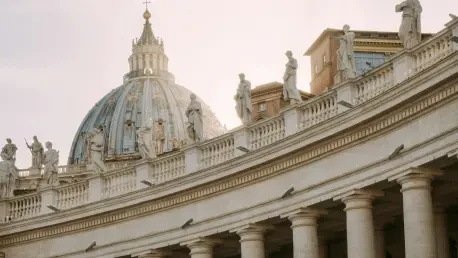In a bold move that has captured global attention, the Vatican is undergoing a significant transformation under the leadership of Pope Leo XIV, who has taken decisive steps to address long-standing financial controversies that have plagued the Holy See for years. Recent actions signal a sharp departure from the policies of his predecessor, Pope Francis, whose financial reforms have been widely criticized for creating structural inefficiencies and credibility issues. From reversing centralized asset management laws to reassigning key personnel, Pope Leo’s initiatives aim to restore trust among international donors and streamline governance within the Vatican. This shift comes at a critical juncture, as the Holy See grapples with ongoing legal battles and donor skepticism. The unfolding changes raise questions about the future of financial transparency in one of the world’s most influential religious institutions, setting the stage for a new era of accountability and reform.
Reversing Centralized Financial Control
Pope Leo XIV has wasted no time in dismantling a key financial policy enacted during Pope Francis’s tenure, marking a significant pivot in how the Vatican manages its vast assets. Earlier this year, an executive decree nullified a 2022 law that had placed exclusive control of the Holy See’s financial resources under the Institute of Religious Works, often referred to as the Vatican Bank. Critics argued that this centralization clashed with the Vatican’s founding constitution, which designates such oversight to the Patrimony Office. The new directive allows the Holy See to engage non-Vatican banks in other countries if deemed more efficient by an investment committee. This change reflects a broader intent to decentralize power and introduce flexibility in financial operations, addressing concerns about inefficiency and lack of oversight that have lingered for years. By redistributing authority, the Vatican hopes to mitigate risks associated with concentrated control and align its practices with modern financial standards.
The rollback of this policy is not merely a bureaucratic adjustment but a strategic effort to rebuild confidence among stakeholders who have expressed doubts about the Vatican’s fiscal management. Under the previous framework, the centralization of assets under a single entity raised red flags about transparency, particularly among international donors who prioritize accountability. Pope Leo’s approach suggests a recognition of these concerns, aiming to create a system where checks and balances are more evident. Furthermore, the decision to involve external banking institutions signals an openness to global financial practices, potentially easing tensions with contributors who have long called for reform. While it remains to be seen how effectively these changes will be implemented, the initial steps indicate a commitment to addressing systemic flaws. This move could pave the way for stronger partnerships with financial entities outside the Vatican, fostering a more robust and credible economic structure for the Holy See.
Restructuring Key Personnel and Commissions
Another critical aspect of Pope Leo XIV’s financial overhaul involves the reassignment of personnel closely tied to the previous administration, signaling a shift in internal power dynamics. Recently, Monsignor Roberto Campisi, a prominent figure associated with Pope Francis and head of a fundraising commission formed earlier this year, was reassigned to a diplomatic role in Paris as ambassador to UNESCO. This commission, intended to bolster donations for the financially strained Holy See, faced scrutiny for lacking experienced fundraisers and excluding significant donor groups, particularly from the United States. The reassignment hints at plans to restructure the commission, possibly by appointing individuals with stronger credentials to enhance credibility. Such changes are crucial, as American donors, who contribute substantially, often demand greater transparency—a quality the Vatican has historically struggled to deliver.
Beyond individual reassignments, the broader restructuring effort underscores Pope Leo’s focus on addressing systemic inefficiencies within key financial bodies. The fundraising commission’s initial setup was seen as a misstep, failing to inspire confidence among those it aimed to engage. By potentially rebuilding this group with more qualified members, the Vatican could improve its outreach and secure much-needed resources to support its global mission. Additionally, these personnel changes reflect a deliberate attempt to distance current leadership from past controversies, creating space for fresh perspectives on financial governance. While the full impact of these adjustments is yet to unfold, early indications suggest a push toward aligning internal structures with external expectations. This strategic realignment may help mend strained relationships with donors and reinforce the Vatican’s commitment to responsible stewardship of its resources.
Engaging Donors and Navigating Legal Challenges
Maintaining strong ties with influential contributors is a priority for Pope Leo XIV, as evidenced by recent interactions with prominent groups like the Knights of Columbus, a leading U.S. Catholic charitable organization. On the same day the new financial decree was issued, a meeting with this group highlighted their role in funding significant projects, such as the restoration of Bernini’s baldacchino canopy in St. Peter’s Basilica. This engagement underscores a deliberate effort to nurture relationships with key donors while addressing concerns about financial management. By publicly acknowledging their contributions, the Vatican aims to reassure supporters of its dedication to impactful initiatives, even as it navigates complex internal reforms. Such diplomatic gestures are vital for sustaining financial support from communities that have historically played a major role in the Holy See’s operations.
Simultaneously, the Vatican faces persistent challenges in achieving credible financial accountability through its judicial processes, with an ongoing trial drawing significant attention. Initially framed as a testament to Pope Francis’s reform agenda, the trial recently convicted a cardinal of embezzlement among other charges but has been marred by procedural errors and defense objections over rights violations within the Vatican’s absolute monarchy system. An appeals court has delayed proceedings until early next year to allow for further review by the supreme court, a body composed of cardinals loyal to the previous administration and lacking formal legal training. This delay highlights the deep-rooted difficulties in ensuring fair and transparent legal outcomes, casting a shadow over efforts to restore trust. Resolving these judicial shortcomings remains a critical hurdle for Pope Leo, as credible accountability is essential to convincing stakeholders of the Vatican’s commitment to reform.
Charting a Path Forward with Reformed Vision
Reflecting on the sweeping changes initiated by Pope Leo XIV, it’s evident that a transformative chapter has unfolded in the Vatican’s financial history. The decisive rollback of centralized asset laws marked a rejection of past inefficiencies, while strategic personnel shifts aimed to rebuild credibility in key commissions. Engagements with major donors reaffirmed the importance of trust, even as legal trials exposed lingering procedural flaws. Each action taken under this new leadership sought to address the troubled legacy inherited from previous policies, striving for a balance between tradition and modern accountability.
Looking ahead, the focus must shift to ensuring these reforms translate into tangible outcomes that withstand scrutiny. Strengthening judicial processes to eliminate procedural errors will be paramount, as will the continued cultivation of donor relationships through transparent practices. Appointing skilled professionals to restructured commissions could further solidify confidence. As the Holy See navigates this transition, sustained commitment to flexibility and oversight will determine whether this bold vision reshapes its financial future for the better.









